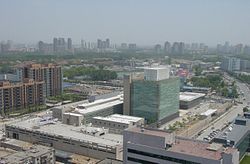Top Qs
Timeline
Chat
Perspective
Embassy of the United States, Beijing
United States diplomatic mission to the People's Republic of China From Wikipedia, the free encyclopedia
Remove ads
The Embassy of the United States in Beijing is the diplomatic mission of the United States in China. It serves as the administrative office of the United States Ambassador to China. The embassy complex is in Chaoyang, Beijing.[1]
Remove ads
In addition to Beijing, it covers the municipalities of Tianjin and Chongqing and the provinces of Gansu, Guizhou, Hebei, Henan, Hubei, Hunan, Inner Mongolia, Jiangxi, Ningxia, Qinghai, Shanxi, Shaanxi, Shandong, Sichuan, Tibet, Xinjiang, and Yunnan.[2]
Remove ads
History
Summarize
Perspective

The current U.S. Embassy in Beijing was opened and dedicated on August 8, 2008, by U.S. President George W. Bush[3] and is the third largest American diplomatic mission in the world, after the Embassy of the United States, Baghdad and the Embassy of the United States, Yerevan. The U.S. embassy had its origins in 1935 when the legation was upgraded into the embassy in Nanjing. However, the central government of the nationalists was relocated to Taipei in 1949 due to the Chinese Civil War and the embassy was reopened in 1953. On January 1, 1979, the embassy was transferred to Beijing after normalizing relations with the communist government on the mainland.[4]
The 500,000-square-foot (46,000 m2), eight story facility incorporates a great deal of free-standing transparent and opaque glass in its design. It is located on a 10-acre (4.0 ha) plot of land. The embassy warehouse is located in the Beijing Tianzhu Airport Industrial Zone in Shunyi District.[5]
Since the embassy is legally out of reach of the Government of China, it was used as the hiding place of Chinese dissident Chen Guangcheng after he escaped from house arrest.[6]
Remove ads
Principal officers
Ambassadors
Deputy Chiefs of Mission (DCM)
Remove ads
See also
- List of diplomatic missions of the United States
- United States Ambassador to China
- U.S. Consulate General Chengdu
- U.S. Consulate General Guangzhou
- U.S. Consulate General Shanghai
- U.S. Consulate General Shenyang
- U.S. Consulate General Wuhan
- Consulate General of the United States, Hong Kong and Macau
- Embassy of People's Republic of China in Washington, D.C.
- International School of Beijing
- Americans in China
Notes
References
External links
Wikiwand - on
Seamless Wikipedia browsing. On steroids.
Remove ads

















